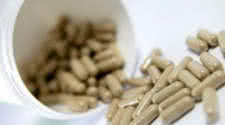Creatine Info: Creatine with Weight Training & Exercise

Advanced Supplementation News & Ground Breaking Research Studies
Creatine is a recent addition to the ergogenic food supplements available to athletes. The furor over this substance stems from a study published in a respected British medical journal, Clinical Science, that showed increased anaerobic power with creatine use. Since weight training
involves anaerobic energy mechanisms-that is, energy produced without oxygen-creatine appears to be useful for bodybuilding purposes.
Creatine phosphate is stored in muscle and acts as secondary phosphate donor to replenish stores of adenosine triphosphate (ATP), which consists of adenosine attached to three phosphate groups. When one of the phosphate groups breaks away, energy is produced. Creatine then donates
a phosphate back to ATP starting the cycle again. While this is an admittedly simplified explanation of energy production, it does show how vital creatine is. Creatine is found in foods such as red meat, but you'd have to eat large quantities to take in appreciable amounts. The
type of creatine used in most scientific studies is creatine monohydrate, which combines with a phosphate group to form creatine phosphate in the body.
A recent study conducted by researchers from Texas Woman's University in Denton and the University of Texas Southwestern Medical Center in Dallas looked at the effects of supplemental creatine on both peak anaerobic power and anaerobic capacity. Peak power was maximum power output
in five seconds, while anaerobic capacity took 30 seconds. This is significant because the ATP-CP system only provides energy for six to 10 seconds during exercise.
The subjects of the study were eight men who had lifted weights for an average of 10 years. They were divided into two groups, with the first group taking doses of five grams of creatine four times a day for 14 days, plus a gram of glucose, and the other group getting six grams of
glucose four times a day. The results showed that peak power wasn't affected, but plasma ammonia levels were higher in the glucose group. The creatine group had no changes in ammonia levels, which indicates more efficient energy production, particularly for exercise lasting 30
seconds.
Another new study that looked at the effects of creatine had a different conclusion, however. Researchers from the Department of Kinesiology at McMaster University in Hamilton, Ontario, checked the effects of creatine on a maximum 30-second power output represented by intense cycling.
This time nine subjects were divided into groups, with some receiving creatine and the others getting a placebo. The first group took 20 grams a day of creatine mono- hydrate for three days, but none of the tests revealed differences in any measure of power between the groups. The
creatine group showed increased levels of free creatine, total creatine and ATP. The researchers concluded that supplemental creatine didn't increase the power output or resting muscle creatine phosphate content.
Previous studies that did show increased power from creatine supplements used larger loading doses for longer times. For example, in the original creatine study subjects took five grams six times a day, for a total of 30 grams. The suggested best time interval for creatine loading
in muscle is five to seven days, not the three days that was used in the Canadian study. The current consensus is that supplemental creatine may be an effective ergogenic aid for power athletes if taken in correct amounts with a proper loading protocol. It's especially effective for
people who avoid red meat, a prime source of natural creatine.